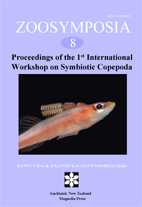Abstract
Females of Neoergasilus japonicus (Harada, 1930) are ectoparasitic on freshwater fishes. While this species is currently known as an alien parasite in southern Asia, Europe, and North America, little information is as yet available on its ecology. In this study, we investigated the occurrence of N. japonicus on freshwater fishes in the Ashida River system in Hiroshima Prefecture, western Japan, in order to evaluate which factors may contribute to variations in the infection level of this parasite between fish species and between sampling locations. Sampling was conducted at five sites in the middle and lower reaches of the Ashida River (the main stream) and at two sites of its tributary, the Takaya River. Twenty-three fish species belonging to seven families were collected, of which ten (eight native and two introduced) benthopelagic species were found infected with N. japonicus. Two centrarchid species of North American origin, largemouth black bass Micropterus salmoides and bluegill Lepomis macrochirus, were more frequently and heavily infected than Japanese native fishes. In both introduced and native fishes, larger individuals showed a higher level of infection. For the fish species that were widespread in the main stream, infection with N. japonicus occurred in the lower reaches only, where current speed was nil and water depth was high. These results suggest that the fish composition, biological aspects (e.g., body size and distribution in the water column) of the fish hosts, and environmental factors such as current speed and water depth are closely associated with the distribution pattern of N. japonicus in the Ashida River system.

